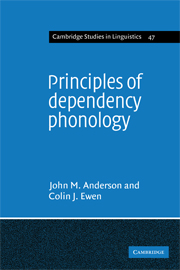Book contents
2 - The structure of phonological sequences
Published online by Cambridge University Press: 04 August 2010
Summary
In chapter 1 we looked at various kinds of evidence relating to the internal structure of segments, including some phenomena involving sequential constraints. We turn now to a consideration of phonological sequences as such, and specifically to the question of their structure, if any.
The past few years have seen a wide range of work on different models of suprasegmental structure, notably on variants of metrical and autosegmental phonology. It nevertheless seems appropriate to us to approach the notion of phonological constituency and related properties from an initially agnostic standpoint. Much of this chapter will therefore be concerned with establishing the validity of concepts which are now commonly taken for granted. Often this confidence is, we would suggest, to some extent unwarranted; and this is in part reflected in debates over the precise character of suprasegmental structure – debates such as that concerning the status of the ‘metrical grid’ (see Prince 1983; Hayes 1984; Giegerich 1986). We delay until chapter 3 an exposition of our own view of the nature of this structure. Here our aims are rather more limited.
We begin by considering what properties should be attributed to sequences of segments, and whether these include constituency. Questions like the following arise. Are some sequential constraints to be associated with a structure that is not simply a concatenation of segments? And even if this structure (e.g. grouping into syllables) is reducible to, or predictable from, the sequence of segments, is generality lost if any other generalisations are attributed directly to the sequence rather than to the structure?
- Type
- Chapter
- Information
- Principles of Dependency Phonology , pp. 41 - 84Publisher: Cambridge University PressPrint publication year: 1987
- 1
- Cited by



